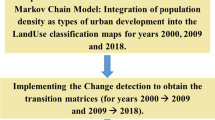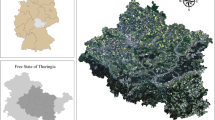Abstract
This study aims to analyze land use patterns using time-series satellite images of Seoul Metropolitan Area for the past 30 years, and present a macroscopic model for predicting future land use patterns using Markov Chain based probability model, and finally examine its applicability to Korea. Several Landsat MSS and TM images were used to acquire land-use change patterns and dynamic land-use change patterns were categorized from the classified images. Finally, spatio-temporal transition matrices were constructed from the classified images and applied them into a Markov Chain based model to predict land-use changes for the study area.
Access this chapter
Tax calculation will be finalised at checkout
Purchases are for personal use only
Preview
Unable to display preview. Download preview PDF.
Similar content being viewed by others
References
Alig, R.J.: Econometric analysis of the factors influencing forest acreage trends in the southeast. For. Sci. 32, 119–134 (1986)
Agarwal, C., Green, G., Grove, M., Evans, T., Schweik, C.: A Review and Assessment of Land-use change Models: dynamics of space, time, and human choice. In: 4th International Conference on Integrating GIS and Environmental Modeling (2000)
Acevedo, W., Foresman, T.W., Buchanan, J.T.: Origins and Philosophy of Building a Temporal Database to Examine Human Transformation Processes. In: Proceedings, ASPRS/ACSM Annual conversion and Exhibition, Baltimore, MD, April 22-24 (1996)
Clark, S., Starr, J., Foresman, T.W., Prince, W., Acevedo, W.: Development of the Temporal Transportation Database for the Analysis of Urban Development in the Balimore-Washington Region. In: Proceeding, ASPRS/ACSM Annual Convention and Exhibition, Balimore, MD, April 22-24, vol. III, pp. 101–110 (1996)
Clarke, K.C., Hoppen, S., Gaydos, L.: Methods and techniques for rigorous calibration of a cellular automaton model of urban growth. In: Third International Conference/Workshop on Integrating GIS and Environmental Modeling, Santa Fe, New Mexico, January 21-25, Santa Barbara: National Center for Geographic Information and Analysis (1996)
Clarke, K.C., Hoppen, S., Gaydos, L.: A Self-modifying Cellular Automata Model of Historical Urbanization in the San Francisco Bay Area. EPB 24, 247–261 (1997)
Huang, O., Cai, Y.: Simulation of land use change using GIS- based stochastic model: the case study of Shiqian County. Stoch. Env. Res. Risk Assess. 21, 419–426 (2007)
Jenerette, G.D., Wu, J.: Analysis and simulation of land-use change in the central Arizona - Phoenix region. Landscape Ecology 16, 611–626 (2001)
Jung, J.J.: Development of Cellular Automata Model for the Urban Growth. Seoul University (2001)
Park, S.: Design and Implementation of an Integrated CA-GIS System. Geographic Information System Association of Korea 5(1), 99–113 (1997)
Park, S., Joo, Y.-G., Shin, Y.-H.: Design and Development of a Spatio-Temporal GIS Database for Urban Growth Modeling and Prediction. The Geographical Journal of Korea 36(4), 313–326 (2002)
Turner, M.G.: Spatial simulation of landscape changes in Georgia: a comparison of three transition models. Landscape Ecology 1, 29–36 (1987)
Kang, Y., Park, S.: A Study on the Urban Growth Forecasting for the Seoul Metropolitan Area. Journal of the Korean Geographical Society, 621–639 (2000)
Author information
Authors and Affiliations
Editor information
Editors and Affiliations
Rights and permissions
Copyright information
© 2010 Springer-Verlag Berlin Heidelberg
About this paper
Cite this paper
Joo, Y., Jun, C., Park, S. (2010). Design of a Dynamic Land-Use Change Probability Model Using Spatio-Temporal Transition Matrix. In: Taniar, D., Gervasi, O., Murgante, B., Pardede, E., Apduhan, B.O. (eds) Computational Science and Its Applications – ICCSA 2010. ICCSA 2010. Lecture Notes in Computer Science, vol 6016. Springer, Berlin, Heidelberg. https://doi.org/10.1007/978-3-642-12156-2_8
Download citation
DOI: https://doi.org/10.1007/978-3-642-12156-2_8
Publisher Name: Springer, Berlin, Heidelberg
Print ISBN: 978-3-642-12155-5
Online ISBN: 978-3-642-12156-2
eBook Packages: Computer ScienceComputer Science (R0)




